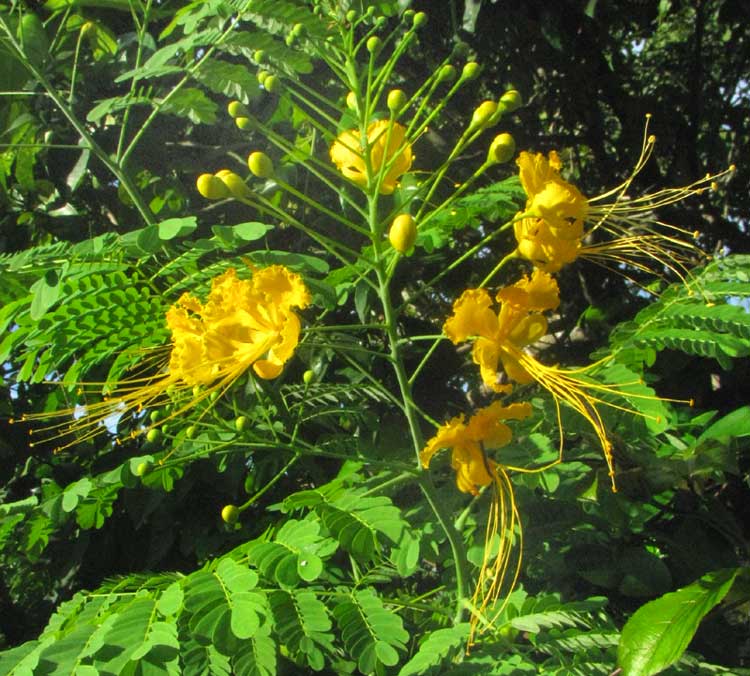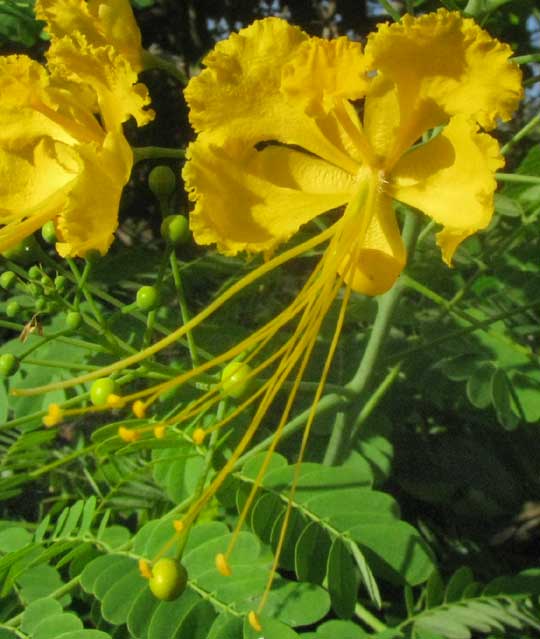Excerpts from Jim Conrad's
Naturalist Newsletter

from the February 19, 2012 Newsletter issued from Hacienda Chichen Resort beside Chichén Itzá Ruins; limestone bedrock; elevation ~39m (~128ft), N20.675°, W88.569°; central Yucatán state, MÉXICO
YELLOW DWARF POINCIANA
Dwarf Poincianas, CAESALPINIA PULCHERRIMA, are native to tropical America but are planted worldwide in the tropics because they're so pretty and easy to grow. Most have flowers like the predominantly reddish ones we photographed back in 2006, shown in the next section.
The other day in backstreet Pisté a cultivar turned up with all-yellow flowers. It was the Yellow Dwarf Poinciana, Caesalpinia pulcherrima 'flava.' You can see the plant's flowers with very long, slender stamens, unopened flower buds, and ferny leaves above. A close-up just so we can admire the two-inch wide flowers (5cm) with their crinkly-margined petals is below:

These are so frequently planted that they're known by a host of names other than Dwarf Poinciana -- such as Peacock Flower, Barbados Pride, Barbados Flower-fence, Red Bird-of-Paradise, and more.
from the March 18, 2006 Newsletter issued from Hacienda San Juan just east of Telchac Pueblo, northwestern Yucatán, MÉXICO
A DWARF POINCIANA'S SNAPPING LEGUMES
I watched the fighting iguanas from the roof of my lodging, with a Dwarf Poinciana, POINCIANA PULCHERRIMA, right below me. I've mentioned how hummingbirds love this little tree's large, red-and-orange blossoms. These trees, watered regularly, somehow have kept blooming ever since I arrived here in October, though now they bear many more fruits than flowers. Below, that's the pretty flowers and feathery, mimosa-like leaves.

On that late afternoon with a very hot wind blowing and the sunlight at its most ferocious, curious snapping sounds began originating inside the tree. It was about as loud as snapped fingers but with a dry, woody character. After looking several times, trying to catch the snapper, finally I saw a split-open seed pod, or legume, tumbling from the tree immediately after a snap.
So, here was another example of explosive seed pods! When the legumes' two sides had sprung apart, seeds had been slung a good distance. Many if not most pods explode with such violence that the entire split-open legume breaks from its twig. However, now I began noticing that some exploded pods, or at least one side of them, remained on the tree, still coiled after the violent split. Usually such remaining pods or parts of pods remaining on the tree are empty of seeds but I found one with a few seeds still attached, showing how the seeds are arranged. Below, you can see it, much-twisted after its explosion.
